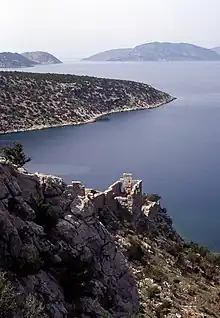
Siphae or Siphai (Ancient Greek: Σῖφαι),[1][2][3][4][5] also known as Tipha (Τίφα),[6] was a town of ancient Boeotia, upon the Corinthian Gulf, which was said to have derived its name from Tiphys, the pilot of the Argonauts. In the time of Pausanias the inhabitants of Siphae pointed out the spot where the ship Argo anchored on its return from its celebrated voyage. The same writer mentions a temple of Heracles at Siphae, in whose honour an annual festival was celebrated.[6][1] Apollonius Rhodius[7] and Stephanus of Byzantium[3] describe Siphae as a dependency of Thespiae.[8]
References
- 1 2 Thucydides. History of the Peloponnesian War. Vol. 4.76.
- ↑ Periplus of Pseudo-Scylax, p. 15
- 1 2 Stephanus of Byzantium. Ethnica. Vol. s.v.
- ↑ Ptolemy. The Geography. Vol. 3.15.5.
- ↑ Pliny. Naturalis Historia. Vol. 4.3.4.
- 1 2 Pausanias (1918). "32.4". Description of Greece. Vol. 9. Translated by W. H. S. Jones; H. A. Ormerod. Cambridge, Massachusetts; London: Harvard University Press; William Heinemann – via Perseus Digital Library.
- ↑ Apollonius Rhodius, Argonautica, 1.105.
- ↑ Stillwell, Richard, ed. (1976). Princeton Encyclopedia of Classical Sites. Princeton: Princeton University Press., s.v. Thespiai.
- ↑ Richard Talbert, ed. (2000). Barrington Atlas of the Greek and Roman World. Princeton University Press. p. 55, and directory notes accompanying.
- ↑ Lund University. Digital Atlas of the Roman Empire.
![]() This article incorporates text from a publication now in the public domain: Smith, William, ed. (1854–1857). "Hyle". Dictionary of Greek and Roman Geography. London: John Murray.
This article incorporates text from a publication now in the public domain: Smith, William, ed. (1854–1857). "Hyle". Dictionary of Greek and Roman Geography. London: John Murray.
38°11′24″N 23°03′10″E / 38.189977°N 23.052885°E